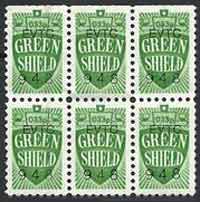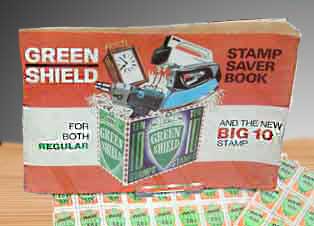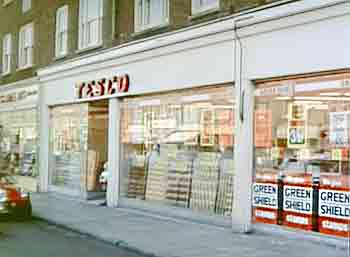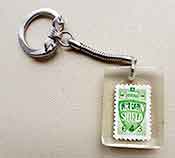Green Shield stamps, the first loyalty stamps in Britain

The Green Shield stamp scheme was an innovation that was an exciting and unique first in the UK in the late 1950s into the 1970s. This page explains how it worked, its origin and its purpose with recollections of its operation.
____
By the webmaster based on firsthand recollections and additional research
What Green Shield stamps were and how the scheme worked
The Green Shield stamp scheme was aimed at increasing custom at participating sales outlets. The stamps were given away to customers, the number of stamps depending on the how much was spent.
The stamp book
Customers stuck their stamps into a book which was given away free and printed with outlines showing where to stick the stamps. This made them less likely to get lost and easier to count. When a book was full, it could be exchanged for a new one at any participating retail outlet. Gifts could be chosen from a catalogue along which gave the price in stamps of each item. Green Shield stamps could not be exchanged for money.

Green Shield stamp book, photographed in Beaulieu Motor Museum

Posters in a window of a Tesco shop, showing that it belonged to the Green Shield stamp scheme. Screenshot from an old film.

Promotional green shield stamp keyring, given away free in participating retailers.
The success of the scheme
Although the value of each stamp was minimal, there was something rather enticing about collecting them, sticking them into their book and watching the collection grow. So I suppose that we did tend to go to retailers who were in the scheme rather than those who were not.
But was it worthwhile for participating shops? It was widely believed that the cost of the scheme had to come from increased prices. However, according to a spokesman for Tesco supermarkets in a radio broadcast, the scheme encouraged such an increase in customers that the increased profits more than covered the cost of the scheme. So why, you may wonder, did it end? This is discussed at the end of the page.
Not all shops or supermarkets belonged to the scheme. Sainsburys, for example, never did, possibly believing that customers would assume increased prices. Also of course, Sainsburys' selling points were quality and freshness whereas, at the time, Tesco's was "Pile 'em high and sell 'em cheap". The piles of cardboard boxes were there for all to see - yes, very different from today.
The headquarters of the Green Shield stamp scheme
The scheme was organised from a tall newly built building in Edgware, where I grew up. The building was known as the Green Shield Tower.
The origin and beginning of the scheme
Green Shield stamps were not the first loyalty scheme in the UK or the first loyalty stamps in the world.
The first British loyalty scheme was the Co-op's dividend scheme - see the link for how it worked. The first loyalty stamp scheme was the American Pink Stamp scheme. Its long-established success was the trigger for Richard Tompkins to introduce the Green Shield British equivalent. That was in 1958.
The end of Green Shield stamps
The Green Shield stamp scheme was relatively shortlived. Like all good things, its success was copied which lead to a trading-stamp war.
Also in the 1970s the UK economy was in trouble. According to the above-mentioned radio broadcast, inflation went to over 25%. I can't vouch for that figure, but I do remember as a young adult that our mortgage went up to 13%. I won't dwell on how incredibly worrying this was for us. The important thing for retailers was that they had to increase their prices. Tesco were increasing prices four times a year to keep pace with the increasing costs of goods and staff wages. It led to a whole new way of running a business.
To meet these 1970s challenges, Richard Tompkins started rebranding the Green Shield business as Argos which is still going strong today. My recollection is that loyalty stamps started petering out after that.
| sources | webmaster | contact |
Text and images are copyright
If you can add anything to this page or provide a photo, please contact me.



